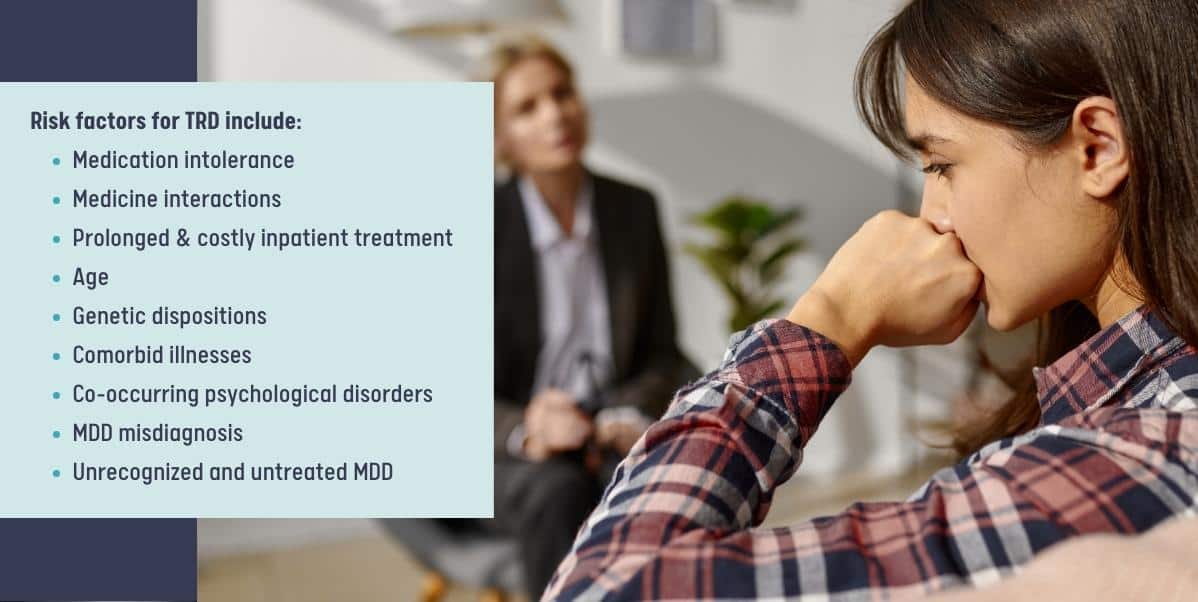
When major depressive disorder (MDD) fails to respond to at least two rounds of traditional and first-line therapeutic options, it becomes treatment-resistant depression (TRD). MDD is a psychological condition characterized by a lack of interest and lingering sadness. Treatment for this debilitating illness usually involves counseling and medication.
Counseling enables people with MDD to establish the root cause of their depression and triggers. They also learn techniques and develop beneficial habits and skills to help them manage the symptoms. Sometimes therapists prescribe antidepressants as an intervention against MDD. Depression medication balances brain chemicals, increasing the likelihood of a person’s response to therapy and reducing the severity of depression symptoms.
During the course of treatment, the therapist monitors the patient’s response to treatment. They may modify approaches and techniques or switch medications if the symptoms do not improve. After a satisfactory level of treatment rounds and antidepressants without any changes in the patient, the therapist can conclude that the patient’s MDD is treatment-resistant.
How Does Treatment-Resistant Depression Occur?
TRD morphs from major depressive disorder (MDD) and is unresponsive to the first line of psychotherapy and pharmacotherapy. Clinical trials show that 1 in every 3 patients fails to respond to antidepressants. Studies also show that MDD remission rates after the first round of treatment is 37% and after the second line of treatment is 31%.
Clinicians agree that several treatment factors can affect the efficacy of therapy and antidepressants. For instance, if the therapist prescribed lower doses compared to the severity of MDD, the medication would become ineffective. The patient’s adherence to therapy and antidepressants also impacts the efficacy of treatment. Consequently, a TRD prognosis requires at least three rounds of unresponsive treatment.
Other Risk Factors for TRD Include:
- Medication intolerance – adverse reactions or side effects to antidepressants can cause the therapist to discontinue pharmacotherapy.
- Medicine interactions – the patient may be taking medications for other conditions that may interact with antidepressants reducing their efficiency.
- Prolonged and costly inpatient treatment – can discourage patients from seeking additional rounds of treatment.
- Age – older adults are more susceptible to treatment-resistant depression than young or mid-life patients.
- Genetic dispositions – like slow metabolism, interfere with the medication’s absorption rate.
- Comorbid illnesses – which activate and sustain the depressive mood like hypothyroidism and anemia, can cause TRD without adequate treatment.
- Co-occurring psychological disorders – eating disorders, substance abuse, and anxiety disorders tend to worsen MDD. They can also be the underlying factor behind severe depression. They require treatment to alleviate depression symptoms effectively.
- MDD misdiagnosis – this also includes misidentification of the actual depression subtype.
- Unrecognized and untreated MDD can also become unresponsive to treatment.

Symptoms of Treatment-Resistant Depression
TRD is a burdensome condition to the individual and society. Although the signs of the disorder are similar to MDD symptoms, there are some debilitating variations. For instance, the symptoms are much more severe and relentless than in MDD. The degree of despair, helplessness, destructive behavior, anxiety, agitation, sleep disturbances, and appetite suppression or augmentation is much higher.
People with TRD also have a high likelihood of getting comorbid mental and physical illnesses – from other mood and behavioral disorders to cardiovascular, digestive, and immune system-related conditions. TRD also increases the risk factor for suicide.
Unfortunately, the burden of treatment costs also falls on the patient. Studies show that patients with TRD have higher hospitalization rates and annual medication costs than those with other types of depressive disorders. Aside from treating depression, TRD patients must seek treatment for co-occurring illnesses. Thus, their overall healthcare requirements are too expensive.
Treating TRD with TMS Therapy
One effective intervention for treating TRD is Transcranial Magnetic Stimulation (TMS) therapy. TMS therapy is a non-invasive procedure approved by the FDA that uses magnetic fields to stimulate nerve cells mediating mood in the brain. Most people with treatment-resistant depression experience a significant improvement in their mood after a round of treatment with TMS.
How Does TMS Therapy Work?
Highly concentrated magnetic pulses get transmitted to the patient’s brain through a treatment coil. The machine works through the electromagnetic laws of physics. The brain carries electrical charges. Nerve cells transfer these charges when they send signals from sensory organs and tissues to the brain, while the TMS coil has a strong magnetic field.
The magnetic field affects the electrical charges in the brain, which, in turn, influences brain activity. The clinician places the TMS coil in the area of the brain responsible for regulating mood to disrupt and rectify electrical charges in that region. Several rounds of this treatment improve the mood of the patient, diminishing the severity of depressive symptoms gradually.
TMS therapy is a safe treatment done under the jurisdiction of a certified mental health caregiver. No cutting, bleeding, stitching, or medication is necessary for the procedure. Treatment gets administered while the patient sits comfortably on a chair. The patient is free to go home after every round of treatment.
How Long Does a Treatment Round Last?
A session of TMS treatment typically lasts less than 5 minutes. The mental health expert determines the period of treatment needed depending on the patient’s condition. The patient is safe to go home after exposure to the magnetic field.
The treatment course takes six weeks. Patients receive a total of 30 sessions within this period. Variations exist in TMS therapy. Therefore, the treatment provider is the best individual to ask about a specific treatment length.
Benefits of TMS Therapy
- Treatment sessions are short and quick.
- The procedure is non-invasive.
- TMS therapy has a high success rate for those with TRD.
- Side effects are minimal and rare compared to antidepressants.
Treat TRD at My TMS Therapy
Treatment-resistant depression is a debilitating mental condition that interferes with your quality of living. TMS therapy may be able to help you finally treat depression. Contact us today to learn more about how we can help treat your depression and get on the right path to recovery!


